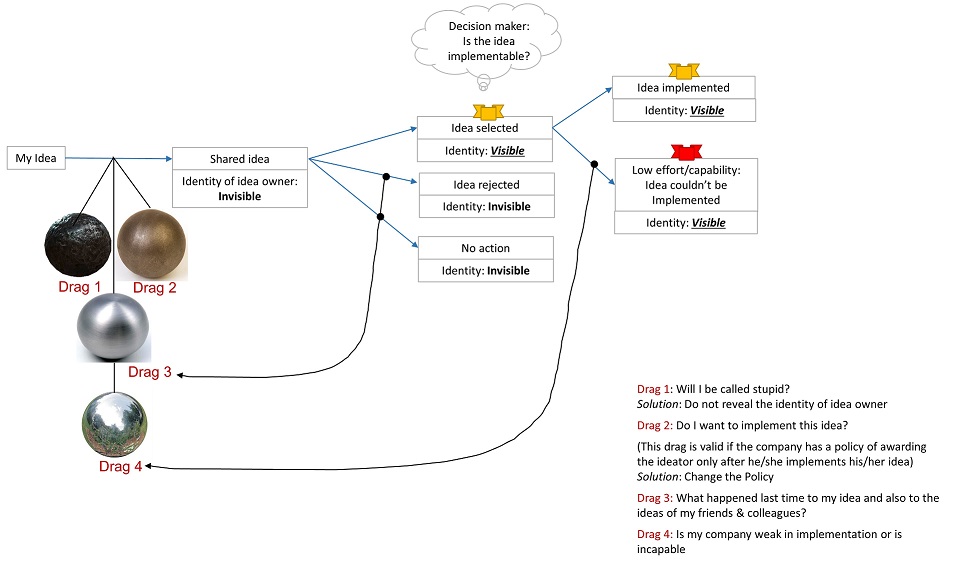In the previous three posts, I had explained how absence of an innovation culture bothers top leaders and why they aren’t able to do much about it. We also discussed how cultures are shaped (cultured) by following processes over a longer period of time. To corroborate my view-point, in my previous post, I gave an example of how culture influences people to share their ideas. This post is the continuation of that example.
Cultural elements required to nurture innovations differ from the time when an idea strikes an individual all the way until the organization gets the return from the innovation. For an idea to get implemented it has to be shared with the person who is willing and empowered to take the risk of experimenting with the idea. It also needs to be shared with all those who need to contribute in the implementation. Only in those rare cases when the ideator feels empowered to implement the idea himself, it may not be necessary to share it.
This first step of sharing ideas has some roadblocks, which I call ‘drags’:
- Drag #1: Will I be called stupid?
- Drag #2: Do I want to work on the idea?
- Drag #3: What happened last time when I gave an idea?
- Drag #4: Is my company willing and capable of executing my idea?
I had explained the first two drags in my previous post. I also gave some examples of processes that could remove these roadblocks.
Drag #3: What happened last time when I gave an idea?
If we overcome the first two drags, employees will be happy to share their ideas. Soon, they will start thinking and evaluating how their past ideas were processed – Did relevant people take decision on the ideas? Was the idea rejected because it was difficult to implement? Was the decision communicated to him? If the idea was selected, were they given a chance to be part of the implementation team? Are they periodically informed about the status of implementation? And lastly if the idea was rejected was the reason for rejection shared? If these are not taken care of, the drag comes into effect!
All the above except one can be addressed through a well-defined process of evaluation and communication. The question, ‘Was the idea rejected because it was difficult to implement?’ is challenging to address because it has subjectivity of the individual. Let me explain:
The decision makers reject ‘difficult to implement’ ideas because they don’t want to be chased for the implementation and seen as non-performers. For such ideas that are ‘difficult to implement’ the decision makers could give a status of ‘Promising’ instead of rejecting them. The measurement system for ‘Promising’ ideas should be very different as compared to ’Selected’ ideas. While selected ideas could be tracked on stage-gate progress, the promising ideas may be tracked on efforts spent! Successful implementation of promising ideas could result in a big upside but there should be no downside if it does not get implemented. Failure to implement a ‘selected’ idea should have a downside if it is not a creative failure.
Drag #4: Is my company willing and capable of executing my idea?
This drag is a result of the perception of employees about the seriousness of their company in implementing innovative ideas. All employees want their ideas to see the light of the day. They feel dejected if their ideas do not get implemented without a valid reason. They don’t mind if the idea is shelved after putting in the requisite effort. Their perception is formed through their own observations, experiences and stories about the rigor in implementing innovative ideas.
Under the influence of this drag (negative perception), employees apply a filter before sharing their ideas. They share only those ideas that they feel will get implemented with the existing rigor. In simpler words, if a person is a world class badminton player, he won’t give any advance-level tips to a novice player because it would be a waste of time. In any conversation between two people, the person with more knowledge or ideas lowers himself to the level of the other person to have an engaging conversation. The same is true with ideas. If the ideator feels that the idea will not get implemented either because the organization is not ready to take risks or is not capable or is weak in execution, he/she will think twice before sharing.
Strike Rate
‘Strike rate’ is measure for an individual, which is not defined but is instinctively used by employees. It is the ratio of ‘ideas implemented’ to ‘ideas occurred in the mind’.
Strike rate = (Ideas implemented) / (idea occurred in the mind)
Strike rate has three components as shown below. The second component is the source of Drag # 3 and the third component is the source for Drag #4. All the four drags influence the first component of the Strike rate.
Strike rate = Sharing Strike rate (known only to respective employee) X Quality Strike rate (known to others) X Implementation Strike rate (known to others)
= (Idea shared) / (idea occurred) X (Ideas Selected) / (Ideas shared) X (Ideas implemented) / (Ideas selected)

Who in an organization would identify the presence of such drags, Design and implement processes to get rid of these and then persist to build the innovation-Culture? – Chief Innovation Evangelist!

